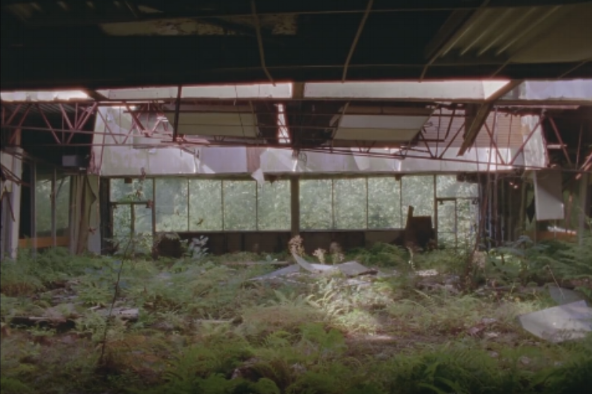Urban Deacy
A curated screening
VIVO Media Arts Centre, June 17th, 2015
EMMEDIA, August 19th, 2015
Role: Curator
Selected Works: Clint Enns, The Everden (2013) 16:33 min., Jessica Thalmann The Ninth Floor (2015) 8:00 min., Eva Kolzce, All That Is Solid (2014) 15:58 min., Theo Tagholm, Simulacra (2015) 3:56 min., Matteo Pasin Molar Formations Urban Cuts (2015) 5:14 min., Ryan Ermacora, Jessica Johnson, and Aidan Whiteley (2015) 13:14 min.
Program Notes:
The works that comprise this program offer a distinct yet conflicted portrait of urban life. These videos articulate the outlook of the artists featured, who have looked upon their environment and determined that though decayed the landscapes presented are capable of renewal. The video producers express a recurring sense of unsettlement through their use of a variety of video formats (16mm film, digital video, and computer generated imagery). The degraded landscapes that are consistently invoked are depicted using film stock or video cameras that are themselves often damaged resulting in physically decayed, distorted, fragmented, or glitched images. The abundance of images presented herein deploy the motif of breakdown anticipated by the program’s title, yet also elaborate on the theme, contemplating decay frequently in relation to transition and regrowth.
In many cases the concept of the bustling urban environment is set up aesthetically in contrast to abandoned spaces. Eva Kolcze’s, All That Is Solid (2014) (Toronto) and Ryan Ermacora, Jessica Johnson, and Aidan Whiteley’s Ocean Falls (2013) (Vancouver) each illuminate sites that appear uninhabited with a somber delicateness. Through their documentation of domains of scholarship and industry, respectively, these artists consider the weight and potential of spaces that once vibrant now sit empty.
Jessica Thalmann’s The Ninth Floor (2015) (New York) considers the imprint of trauma on place, traversing the empty halls and stairwells of Concordia University. The beautiful vacancy so central in this work serves as a trace and memory of the massacre that took place within these walls in 1992.
Brutalist architecture emerges as a recurring visual theme within this program, occupying the aesthetic minds of both Thalmann and Kolcze. They are fascinated perhaps by the false or naive utopianism of this stark concrete architectural style. A utopian dream that with time has transformed into an apocalyptic playground.
Clint Enns’s, The Everden (2013) (Toronto), illustrates the precarity of urban existence through the use of a broken camera that renders his landscape at once foreboding and fragile. The ghostly fields and glitchy vistas captured on Enns’s camera intimate a dystopian future that is uninhabited and inhospitable. Traces of humanity remain but are quickly erased by the noise that engulfs the screen.
Both Simulacra (2015) (UK), by Theo Tagholm and Molar Formations Urban Cuts (2015) (Milan) by Matteo Pasin consider the chaotic impacts of technology on the spaces that humans reside. The, at times overwhelming, imagery and sound that define these videos illustrate a future that is both simulated and stimulating to the point of exhaustion.
Scenes from Montreal, to Milan, from Vancouver, to London, each illustrates the effects of living on the physical landscape. Each work included in the program operates as a provocation – a portrait of humanity’s surroundings cast with a lens of unnerving pessimism. Despite an overarching quality of doubt the artists seem to retain a faith that a place is defined by those who animate it and it is up to those occupy space to resurrect sites that are considered by most, too far gone.
